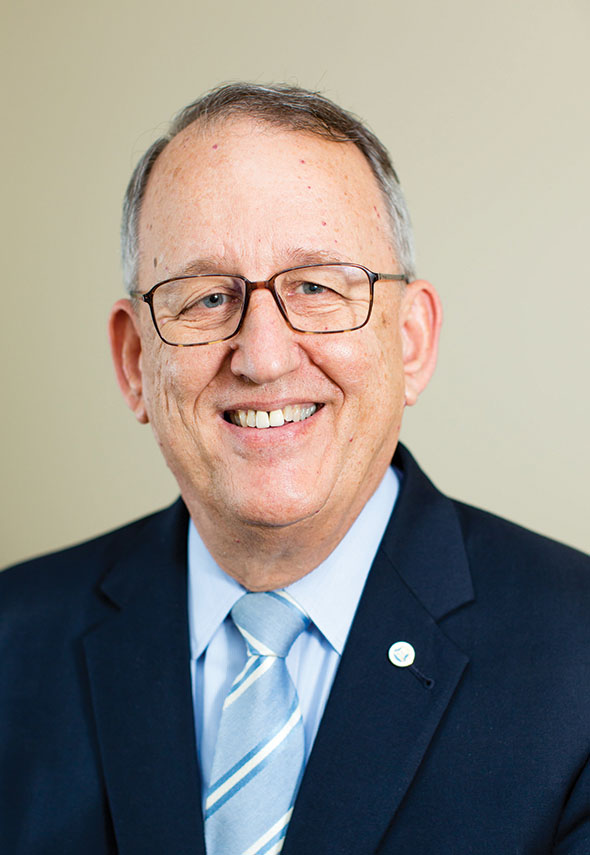Speaking of Governance
Posted on March 6, 2019Recent news reports have led to logical questions about how North Carolina’s system of public higher education is governed.
Before 1972, when the UNC System for Higher Education was formed by the N.C. General Assembly, six universities were presided over by a 100-member Board of Trustees chaired by the governor. In 1971, Gov. Robert Scott proposed adding North Carolina’s other 10 public colleges and universities.

Douglas S. Dibbert ’70
That was opposed by many, including UNC System President William Friday ’48 (LLB), concerned that “leveling” would occur as limited state resources were spread among 16 institutions. Opponents believed that, over time, such leveling would put Carolina’s excellence in jeopardy. But when it became clear that Scott would prevail, Friday worked with lawmakers on legislation that created a 32-member Board of Governors — 16 elected by the N.C. Senate and 16 by the House. Boards of trustees with 13 members also were provided for at each institution — four appointed by the governor, eight by the Board of Governors, plus the student body president. (The Legislature also provided for BOG representation of women, minorities and members of the minority party. Threatened by a lawsuit over “quotas,” these setasides ended in 2001.) Subsequent legislation is now reducing the BOG — to 28 members in 2017 and moving to 24 in July.
With the legislative majorities changing after 2010, followed in 2016 by a governor of the opposite party, legislation removed the governor’s authority to appoint four trustees to boards of trustees and provided for the House speaker and the Senate president pro tempore to each appoint two trustees.
The BOG was briefed on its three roles in July 2017, when new members made up half of the board, by Belle Wheelan, president of the Southern Association of Colleges and Schools Commission of Colleges: policy-making; hiring, evaluating and, as necessary, firing the CEO; and fiduciary responsibility. She noted the “clear and appropriate distinction between policy-making and responsibility of administration and faculty to implement policy.” Wheelan also emphasized the BOG’s duty to “maintain freedom from undue influence from political, religious or other external bodies.”
Boards of trustees are not governing boards; rather, they have delegated authority from the BOG in areas such as personnel actions including chancellor selection, academic degrees and grading, admissions, honorary degrees, property and buildings, endowments, tuition and fees, intercollegiate athletics, traffic and parking, and campus security.
Since 1945, when Robert House (class of 1916) became Carolina’s first chancellor, there have been 11 UNC chancellors. (Until it became illegal to enforce mandatory retirement based on age, chancellors could serve until they were 65. When Friday expressed his desire to serve beyond 65, the BOG declined to make an exception.)
Chancellors report to the UNC System president, who reports to the BOG. One chancellor, Paul Sharp, stepped down after he concluded his authority as CEO was too restricted. Three chancellors, after their service, became law school faculty members — William Aycock ’37 (MA, ’48 JD), Ferebee Taylor ’42 and Paul Hardin. Chancellor Michael Hooker ’69 died in office in 1999. In two cases, Friday asked the Board of Trustees to vote to remove chancellors, but it declined. After retiring, House, Aycock, Carlyle Sitterson ’31, Taylor, Chris Fordham ’47, Hardin and James Moeser remained in Chapel Hill.
Prior to Arts and Sciences Dean Kevin M. Guskiewicz being named interim chancellor in February, Carolina had had one acting or interim chancellor: William McCoy ’55, after Hooker’s death; also, in 1956-57, Friday was acting System president before the “acting” was removed.
The BOG has had 17 board chairs; 12 of those were Carolina alumni, including six of the past eight.
Our alma mater was the second university in the South to be invited into membership in the prestigious Association of American Universities, which includes the 62 top research institutions in North America. Frank Porter Graham (class of 1909) was UNC president when the College for Women in Greensboro and N.C. State College of Agriculture and Engineering at Raleigh were consolidated with UNC to form the three-campus “Greater University.” He represented UNC at AAU meetings throughout his presidency. Friday wished to continue attending AAU meetings, and the 1971 legislation reorganizing public higher education in North Carolina renamed Carolina “the University of North Carolina at Chapel Hill” and assigned “The University of North Carolina” to the system. Eventually, the AAU made clear that only CEOs of research universities could serve on the AAU, and in 2000, Moeser became the first chancellor to represent Carolina at AAU meetings. In 2018, under UNC System President Margaret Spellings, the BOG also approved a rebranding, so the 16-member system of higher education is now officially known as the “UNC System.”
With record applications for undergraduate admission, increasing philanthropic support and research productivity of Carolina’s faculty (now ranked No. 5 in federal research funding), our alma mater has never been stronger. Alumni and friends should remain fully informed, enthusiastically involved and unfailingly supportive.
Yours at Carolina,

Douglas S. Dibbert ’70
